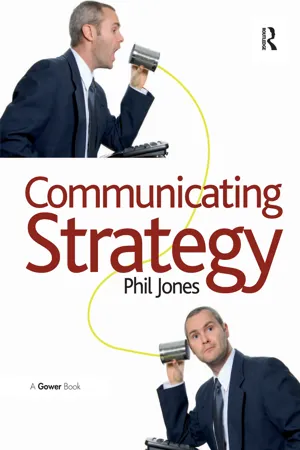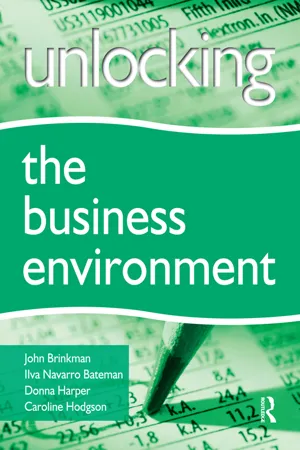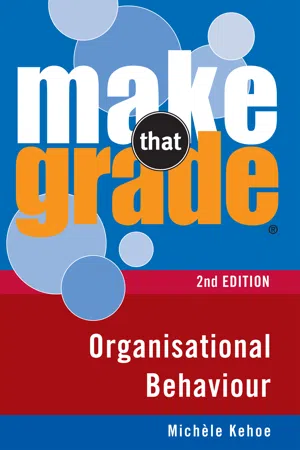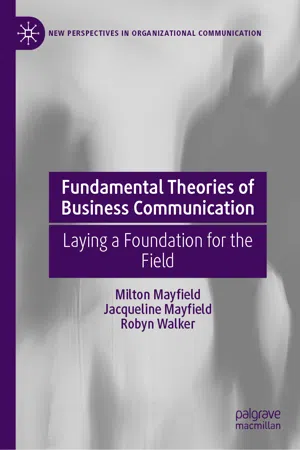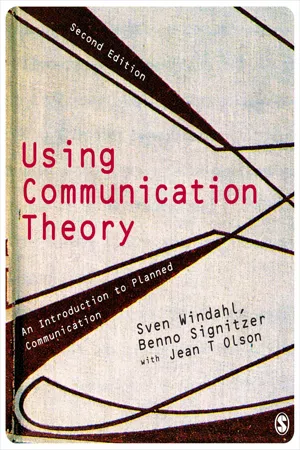Communication Channels
Communication channels refer to the various methods through which information is transmitted within an organization. These channels can include face-to-face interactions, emails, phone calls, video conferences, and written documents. Effective management of communication channels is crucial for ensuring that information flows smoothly and efficiently throughout the business, ultimately contributing to improved productivity and collaboration.
8 Key excerpts on "Communication Channels"
- eBook - ePub
Solutions
Business Problem Solving
- Frank Fletcher, Eric Bolland, Eric Bolland(Authors)
- 2016(Publication Date)
- Routledge(Publisher)
...Body language, posture, eye contact, and facial expressions clue receivers to the subconscious thoughts of the sender. For example, managers who use good posture, appear relaxed but confident, make good eye contact, and smile occasionally, appear to be authoritative and sincere. It is important for written, verbal and nonverbal messages to be consistent and harmonious. Listening to a concert with one of the choir members singing off key detracts from the experience. Similarly, the message can get lost if the sender’s written, verbal, and nonverbal signals are dissonant. For example, if the sales manager’s written message introduces a new service line, but his voice and nonverbal communication suggests doubt about its potential, the sales force may come away from the meeting less than motivated. The resulting impact of incongruent messages may be disastrous for the company. What are the channels of business communication? Business messages are distributed through communications channels or media. Development of information technologies in recent years has given managers more channel options than ever before. Channels have unique characteristics that meet specific communications needs. For example, interpersonal communication offers more opportunities for face-to-face exchange, while web-based channels allow communication en masse—with potentially millions of people all over the world. Selection of appropriate channels is driven by the purpose of the communication and the size and needs of the organization. Face-to-face interactions provide the best channels for interpersonal communications. These types of interactions may be one-to-one, in small or large group settings, via the telephone, or over the Internet in the form of video-conferencing. Effective interpersonal communications are best achieved in one-to-one or small group settings...
- eBook - ePub
- Phil Jones(Author)
- 2017(Publication Date)
- Gower(Publisher)
...Whether this was first initiated by the French management, the local management or the unions and workers is unclear. The closures did not affect the French plants. This led to some suggestions that inefficient French plants were being saved by sacrificing the British plants. 3 The important thing is to be conscious that these tensions exist. That way you can explain why you were unable to communicate them beforehand. Channels and Their Effectiveness At the start of this chapter we had the example of an organization that created a communication strategy by documenting the communications channels it currently had. In contrast, we have concentrated on: Who is important in this strategy? What response do you want? What do they need to know? What are the real connections? When do they need to know? How do we get to these people? What channels exist already and how effective they are? The purpose of your Communication Channels is to get to as many of your targets, as reliably and quickly as possible and get maximum feedback. So in choosing the channels, there are six main criteria. These are: Does it provide feedback or is it one way? Is it reliable? Can I control the message that passes through it? Can I communicate a rich message or only a simple one? Will it go to many people or only a few (broadcast or narrowcast)? Will it be a personal or an impersonal message? How long does it take to prepare? How long does it take to communicate, once it is ready? The channels split into three main groups. Face-to-face Communication Channels rely on a personal contact. They include individual meetings, team meetings, large gatherings and conferences, as well as the informal networks. Electronic channels provide a powerful way to get a message out quickly. They include email, phone, messaging, blogging, message boards and discussion forums...
- eBook - ePub
- John Brinkman, Ilve Navarro, Donna Harper(Authors)
- 2014(Publication Date)
- Routledge(Publisher)
...Diagonal communication cuts across hierarchical levels and functional work areas. Channels/methods of communication As we have seen, people tend to communicate with the same people in fairly predictable patterns. We shall now go on to consider how people undertake their communication, i.e. what channels/methods they use. There are so many ways that you can communicate with someone. A basic approach is to view communication as being either verbal (which includes oral and written communication) or non-verbal. Of course, oral and non-verbal communication such as body language occurs at the same time (except where you cannot see the person with whom you are talking, for example, over the telephone). New technology has also enabled new forms of communication to be possible, e.g. video conferencing, teleconferencing, and email. Every channel/method of communication will have its pros and cons, and each one varies in its information richness. Table 5.1, On pages 104–105, provides an overview of a range of typical Communication Channels/methods encountered in the organisational context, and some of their associated pros and cons. Table 5.1 Communication Channels/methods, and some of their pros and cons Key Terms Communication Channels differ in their capacity to convey information, and this is referred to as their level of richness. Some methods of communication are regarded as richer than others, in that they have the ability to: • handle multiple cues, e.g. aural and visual, simultaneously • facilitate rapid feedback and • be very personal. Methods of communication are typically placed along a continuum of low-channel richness to high-channel richness. Richer forms are more likely to help ensure that a shared meaning occurs as a result of the communication. Figure 5.4 Information richness of some forms of business communication (Robbins, S.P. (2005) Organizational Behaviour. 11th edn. Harlow: Pearson) Activity Imagine that you work as a middle manager for an organisation...
- Vicente Goncalves, Carla Campos(Authors)
- 2018(Publication Date)
- Auerbach Publications(Publisher)
...It is worth emphasizing that incorrect channels can increase distortions of the message. Written communications, especially emails, are usually understood with the emotion of the reader and not of the sender. The organizational culture is an important factor to take into account when deciding the best medium to be used in each circumstance. There are cultures where interpersonal relationships are so important that the mere issuance of email does not produce the desired effect and gives rise to mistaken perceptions that the message is unimportant. The change manager’s sensitivity will be fundamental for determining those stakeholders who require additional, direct and individual communication in addition to the other media used to communicate the same message. Answer Communication is a two-way street. The change manager should inform participants about the feedback channels to be used for each message he or she sends. These channels must be clear and, whenever possible, part of the message itself. In many cases, listening will be the most important part of communication, as it is possible to infer from feedback the stakeholder’s mood, the team’s level of stress, the willingness to change, the level of engagement, possible barriers to be overcome, etc. When people express their emotions about the change, they establish a connection with the change, turning a contained negative energy into a state of active participation. The answer has a fundamental, practical function as well...
- eBook - ePub
Internal Communications
A Manual for Practitioners
- Liam FitzPatrick, Klavs Valskov(Authors)
- 2014(Publication Date)
- Kogan Page(Publisher)
...Employees should believe that when they go to their trusted point of reference, the information they can access will be relevant, up to date and useful. Talk channels Communication managers believe that their role entails managing some form of dialogue. Later on we discuss the role of channels in drawing together a community or in promoting engagement. Even if community and engagement do not matter to your organization, it is likely that you will want to promote discussion as a way of building understanding. Most of us develop our understanding of information or ideas by asking questions or by taking part in some form of conversation. We need a place where we can ask how something is new, what we have to do about an instruction or explore practicalities. Digital media has considerable promise inside organizations to help colleagues talk and react to information. Microblogging tools like Twitter, Yammer, Socialtext and even larger platforms such as SharePoint give employees a place to comment or to check if they have heard something correctly. Face to face remains one of the main mechanisms for conversation – either through line management (the subject of Chapter 7) or through fora such as town hall meetings or opportunities to sit down with senior executives over lunch. A good starting point for a communication manager is to ask whether every employee has a space where they could take part in a debate or a discussion if they so chose. Community channels Sociologists have long known that being part of a community or a team is one of the reasons many of us go to work. When we feel part of something we work harder and are more committed, which has a positive effect on staff turnover and absenteeism. Strong communities at work are more collaborative and, experience shows, generally achieve better results...
- eBook - ePub
- Michele Kehoe(Author)
- 2013(Publication Date)
- Gill Books(Publisher)
...These channels are authoritative and are usually used to communicate policies, procedures and other official information. They generally take the form of meetings, memos, e-mails and voicemails. Informal channels coexist with formal channels of communication, but diverge from the organisation’s hierarchy of authority. They consist of personal and social messages. Informal channels allow unofficial information and rumours to circulate among networks of friends and acquaintances. This type of channel is referred to as the grapevine and gives people a sense of security, gained from knowing what is going on, and a sense of belonging. It satisfies people’s social needs and may happen in person, such as in the so-called ‘water cooler moments’, but also through e-mails, texts and social networks. Rumours can be very dysfunctional at all levels of an organisation and their degree of accuracy should always be questioned. 11.2 Communication process Communication is a social process and involves the transfer of information between one person, group or organisation to another person, group or organisation. It involves the process of the passage of information from one party to another. This process is best represented by a simple model of communication between two persons: the sender and the receiver. The sender is the source, or originator, of the communication and the receiver is the recipient of the communication. Figure 11.1 The communication process Source The source of communication may be an individual, group or organisation. The source is responsible for preparing, encoding and entering the message into the transmission medium. Encoding The message is translated by the source from an idea or thought into symbolic form. Symbols include words, numbers, pictures, sounds and gestures. It is important that both the source and receiver attach the same meaning to the symbols in order to avoid ambiguity and confusion...
- eBook - ePub
Fundamental Theories of Business Communication
Laying a Foundation for the Field
- Milton Mayfield, Jacqueline Mayfield, Robyn Walker(Authors)
- 2020(Publication Date)
- Palgrave Macmillan(Publisher)
...© The Author(s) 2020 M. Mayfield et al. Fundamental Theories of Business Communication New Perspectives in Organizational Communication https://doi.org/10.1007/978-3-030-57741-4_5 Begin Abstract 5. Channels and Barriers Milton Mayfield 1, Jacqueline Mayfield 1 and Robyn Walker 2 (1) Texas A&M International University, Laredo, TX, USA (2) Marshall School of Business, University of Southern California, Los Angeles, CA, USA Jacqueline Mayfield Email: [email protected] Keywords Barriers Business Communication Channels Descriptions Theory End Abstract Something there is that doesn’t love a wall —Robert Frost, Mending Wall Chapter Theories Business English as a Lingua Franca Communication Apprehension Communication Competence Genderlect Theory Information Theories Media Naturalness Media Richness Theory Media Synchronicity Theory Multimodality Social Presence Theory Source Credibility Uncertainty Reduction/ Initial Interaction Theory We should value clear messages in any business. communication. By clarity, we mean transparency, or “sharing [all] genuine information that is relevant to an employee’s work in a timely manner” (J. Mayfield & Mayfield, 2018c, p. 52). Transparency leads to increased engagement, workplace trust, organizational commitment, and perceived leader effectiveness (Holmes & Parker, 2017 ; J. Mayfield & Mayfield, 2018c ; Norman, Avolio, & Luthans, 2010). Just as important, clear business communication matters because it is ethical. We will discuss this impact in more detail later in this introduction. Theories in this category reap the advantages of transparency by giving us the tools to understand and examine the barriers to clear communication and the channels through which communication (clear or not) travels. Plus, these same theories explore the bedrock requirements of communication—how to send a message...
- eBook - ePub
Using Communication Theory
An Introduction to Planned Communication
- Sven Windahl, Benno Signitzer, Jean T Olson(Authors)
- 2008(Publication Date)
- SAGE Publications Ltd(Publisher)
...This objective points out the danger of using pseudo-communicators: if they are not carefully chosen, the impact of the message that pseudo-communicators convey may backfire, for example, if they are perceived as representing groups or interests other than those intended. For example, a traffic safety campaign launched by several semi-private organizations under the umbrella of and partly financed by the Federal Ministry of Transportation may come under attack from some opposition parties who charge that the campaign is actually designed as an image-boosting device to enhance the minister’s chances in the upcoming elections. The sincerity of the motives may be called into question. Medium and Channel ‘Medium’ and ‘channel’ often are used interchangeably, although several communication scientists distinguish between the two concepts. ‘Channel’ denotes ‘the physical means of carrying the signal’ (O’Sullivan et al. 1983: 31–2). It has little to do with meaning, but rather refers to the capacity to carry information. A ‘medium’ is ‘an intermediate agency that enables communication to take place’ (ibid.: 134) through the use of one or more channels. Usually the term is used synonymously with ‘mass media’ – reflecting, perhaps, a communication society that too often forgets that human beings also take on the role of medium. There are communication situations where it is important for the communication planner to define the channels and media available. This enables planners to assess better what resources they have at their disposal. In a health campaign, for example, the channels-to-hand to convey a message in a hospital would include the loudspeaker system, staff meetings, employee newsletters, closed circuit television, and so on; the hospital itself would be regarded as the medium. Message and Content What is transmitted in the communication process is called the message...

